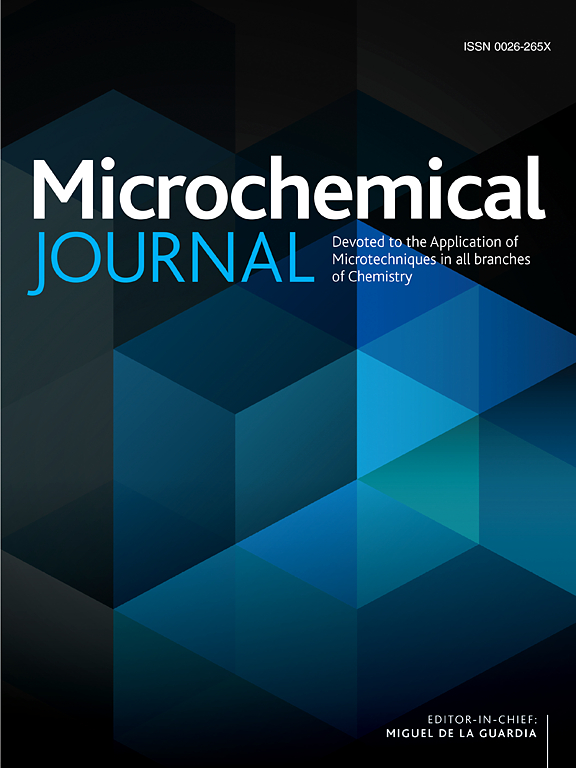胞苷- h3bo3超分子水凝胶纸质流量传感器检测碱性磷酸酶
IF 4.9
2区 化学
Q1 CHEMISTRY, ANALYTICAL
引用次数: 0
摘要
碱性磷酸酶(ALP)是血液相关疾病的重要生物标志物,在医学和生物学研究领域具有重要意义;因此,精确检测ALP是必不可少的。在此,我们报告了一种新型的纸基流量传感器的开发,该传感器用于检测ALP,该传感器利用Ag+作为交联剂创建胞苷硼酸(H3BO3)超分子水凝胶,将水固定在凝胶基质中。引入l-抗坏血酸-2-磷酸(AAP)后,ALP特异性催化AAP水解为抗坏血酸(AA),触发Ag+还原为Ag0。这种反应破坏了水凝胶体系,使水沿着pH指示条流动。在pH指示条上的水流覆盖面积和离心后上层水溶液的体积的量化使ALP测定的执行成为可能。值得注意的是,该方法采用pH指示剂条,无需复杂的设备,检测阈值低至3.1 mU/mL,并且具有高特异性水平。通过对血清中ALP的有效检测,验证了该方法的适用性。总而言之,这种方法为ALP检测提供了一种简单、经济、用户友好的系统,不需要复杂的传感器或昂贵的设备,并且在未来的应用中具有重要的前景。本文章由计算机程序翻译,如有差异,请以英文原文为准。

Detection of alkaline phosphatase via a paper-based flow sensor constructed by cytidine-H3BO3 supramolecular hydrogels
Alkaline phosphatase (ALP) is a critical biomarker for blood-related diseases, with significant implications in the fields of medicine and biological research; hence, precise detection of ALP is indispensable. Herein, we report the development of a novel paper-based flow sensor for detecting ALP by utilizing Ag+ as a cross-linking agent to create cytidine-boric acid (H3BO3) supramolecular hydrogels that immobilize water within the gel matrix. Upon introduction of l-ascorbic acid-2-phosphate (AAP), ALP specifically catalyzes the hydrolysis of AAP to ascorbic acid (AA), triggering the reduction of Ag+ to Ag0. This reaction disrupts the hydrogel system, enabling water to flow along the pH indicator strip. The quantification of both the coverage area of water flow on the pH indicator strip and the volume of the upper aqueous solution after centrifugation enables for the execution of an ALP assay. Notably, this method employing pH indicator strips eliminates the need for complex equipment, achieves a low detection threshold as low as 3.1 mU/mL, and exhibits high specificity levels. Furthermore, the method's applicability has been validated through the effective detection of ALP in serum samples. To summarize, this approach presents a straightforward, cost-effective, and user-friendly system for ALP detection without requiring sophisticated sensors or costly equipment and it holds significant promise for future uses.
求助全文
通过发布文献求助,成功后即可免费获取论文全文。
去求助
来源期刊

Microchemical Journal
化学-分析化学
CiteScore
8.70
自引率
8.30%
发文量
1131
审稿时长
1.9 months
期刊介绍:
The Microchemical Journal is a peer reviewed journal devoted to all aspects and phases of analytical chemistry and chemical analysis. The Microchemical Journal publishes articles which are at the forefront of modern analytical chemistry and cover innovations in the techniques to the finest possible limits. This includes fundamental aspects, instrumentation, new developments, innovative and novel methods and applications including environmental and clinical field.
Traditional classical analytical methods such as spectrophotometry and titrimetry as well as established instrumentation methods such as flame and graphite furnace atomic absorption spectrometry, gas chromatography, and modified glassy or carbon electrode electrochemical methods will be considered, provided they show significant improvements and novelty compared to the established methods.
 求助内容:
求助内容: 应助结果提醒方式:
应助结果提醒方式:


